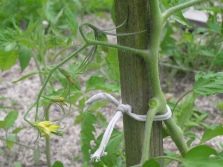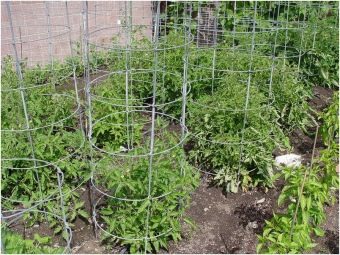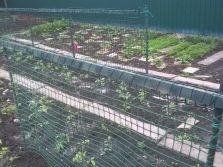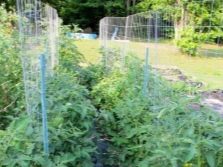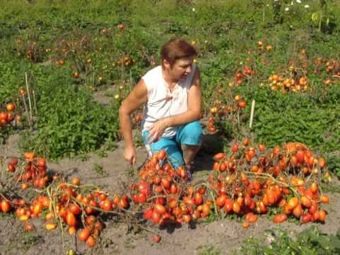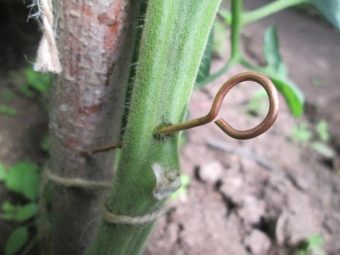How to tie up tomatoes?
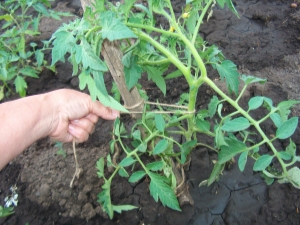
Tomatoes are vegetables that have long been loved by almost all summer residents and gardeners, and therefore this crop can be found today on the beds of any land plot. This state of affairs does not cause much surprise, since the independent cultivation of this vegetable is a rather interesting process, and with the right approach, one can harvest a plentiful harvest of tasty fruits even from one small bed. There are many varieties of tomatoes, bred by professional breeders and amateurs, among these varieties are low-growing and tall plants.
In our climate zone, it is the plants of the tall type that are planted for the most part, since it is they that produce large-sized tomatoes. Of course, the cultivation of such tomatoes will require certain costs of both labor and time. In order to really harvest a good crop of tomatoes, farmers agree to tie them up. For what exactly it is necessary to do it, and how to tie up plants correctly, we will consider further in the article.
What is needed?
Many tomato varieties have a fairly strong stem, but despite this fact, experienced farmers insist that the garter is necessary. It is especially important to carry out this procedure with tall tomatoes, since in some cases the height of such plants can reach two meters. Low-growing tomatoes are almost never tied up, but now they are planted not so often, because it is simply unprofitable to do this - in order to effectively use the available space on the plot, it is better to plant tall plants.
Garter tomatoes is an extremely important event, because it performs a number of useful functions. First of all, this is done, of course, so that the plant stems do not break and do not bend down as they grow due to the weight of the fruit filled with juice. Thus, the vitality of the vegetable is spent not on surviving, but on giving the maximum amount of fruit. In addition, the garter helps to properly arrange the bush, that is, vertically - so it will be completely open to the sun and fresh wind, which contribute to the rapid growth and development of the vegetable.
If you tie up tomatoes that grow in open space, then the likelihood that precipitation can harm the bushes is reduced to a minimum. When the bush grows vertically, its green part and the developing tomatoes will not rot in the ground with excess moisture.
No less important is the fact that the tied bush is easier to handle, easier to spray, spud and mulch. When watering this crop, it is impossible to allow water to fall on the leaves of the bush, and due to the garter to comply with such a rule will be much easier. And also at the tied-up tomato the fruits will be located quite far from the ground, which will protect them from all sorts of pests.
Thus, we can conclude that tall tomatoes still need to be tied up. The sophisticated gardeners and gardeners begin to use the garter devices about two to three weeks after planting the seedlings. There are many ways to tie up tomatoes that grow in the open air, each of which has its own advantages and disadvantages.
rules
To begin with, it should be noted that in different climatic zones, everything is different. So, agrotechnologists are arguing about whether it is advisable, in general, to tie up tomatoes in southern latitudes. In the south, tomatoes growing on plantations get enough ultraviolet radiation, and they can only be tied up so that the fruits that lie on the ground do not attack pests. And you can also tie up the highest bushes.
In areas where climatic conditions are not so favorable, garter becomes necessary. Frequent rains and low temperatures, especially at night, can not only cause trouble, but also completely destroy the crop.In order for tall bushes of tomatoes not to touch the ground, it is necessary to carry out a number of works, in particular, to tie them up correctly.
One of the most important moments is the correct choice of material for plant garters. It should be remembered that these vegetables do not like when something hits a stalk, and therefore hard materials such as wire or fishing line will have to be eliminated. In no case can you use the garter left over from last season, because there are often pathogens and various pathogens that can greatly harm the crop. A bad idea would be to use natural fabrics because they rot, serve as a haven for bacteria, pests and insects.
Thus, in order to tie up the tomatoes, some synthetic material with a low coefficient of rigidity will suit. It can be cords of caprone, twine or any rope, as long as they are wide and thick. What grapes tied up with will fit, most often it is old stockings or knee-high socks.
Before proceeding to the garter, the material should be processed, that is, disinfected by washing or boiling. It is important to remember that regardless of the chosen method of plant garter, the material should not compress the stems of a growing vegetable tightly. The main rule with a garter is to leave a small distance between the peg and the plant itself, taking into account future growth. Depending on the type of tomato in the process of growth, it will need to be tied up two to four times.
Adaptations
There are a lot of devices for a garter, and the most widespread are, perhaps, stakes. A garter with stakes makes it possible to effectively maintain the plants in an upright position. In addition, this method is extremely simple - you just need to drive a peg next to the bush and carefully tie it without damaging the stem. If necessary, you can bind the tomato in several places. For this procedure, you need to pick up the pegs so that they are about twenty centimeters above the plant itself.
Tomatoes are attached to the stakes using any small pieces of fabric. Optimally for this purpose, suitable synthetic material, rather than natural, as it will not be able to rot and spread rot to the plant. You can use special clamps, which are sold in country shops, they are designed specifically for high-quality fastening of plants. The garter is made as high as possible, but it should not be very tight to tie a knot - this way you can kill a tomato bush. As the bush grows and develops, it will be necessary to move the garter higher and higher, and then, if necessary, bandage it again.
Sometimes tying up tomato plants on pins is simply uncomfortable, in particular, when it comes to a large number of bushes growing in open ground. In this case, gardeners resort to one of the most effective alternatives and tie up vegetables on the trellis. To do this, you will need to find strong stakes, as well as a bar, which should be long and thin. Then the stakes are driven in on a different side of the bed and between them the wire is pulled, to which, in fact, the bushes of the tomatoes are tied.
This method of tomato garter has several variations. One option assumes that the wire will be fixed between the bars at a distance of about two meters from the ground, and between it and the stems of the tomatoes there will be a long string. As the bushes grow, the stalks will curl around the twine. But it is also possible to make several rows at once with the help of a wire, firmly fastening it on the bars driven into the ground.
With this method, it will be necessary to attach each plant several times to a wire stretch, thus arranging something like a wicker of bushes.
As an alternative method of garter, you can try to make cages for plants, but this will only make sense if there are a lot of tomato bushes. The cells show themselves well with tall varieties of tomatoes. It should also be borne in mind that this way of garter is very laborious, however, the cells will not need to be changed every year - they are able to serve several seasons. To build cages for bushes, you need to take reinforcing rods and install them vertically, then wrap them with thinner rods. Then the resulting racks are additionally wrapped with hard wire, after which a tomato seedling can be planted inside the cage.
To make a cage for tomatoes, you can use wooden sticks. Such a design can be so large that it will serve as a support for four plants at once. These are quite practical structures, besides, among all the methods of garter, this is perhaps the most aesthetic - the cells of wood, combined with green bushes and red fruits, look very beautiful.
Ways
There are a lot of ways to garter tomatoes. Some of them are best suited for growing this crop in the open field, others are intended solely for the greenhouse or greenhouse. Below we consider some of them depending on the type of cultivation.
In the open ground
This method of growing tomatoes provides a large number of options for tying up tomatoes. It can be tied up on stakes, on a trellis or with a metal or wooden cage. Another way to garter this culture involves the use of a special metal mesh, which, if necessary, can be transferred from one place to another. Growing tomatoes in the open field is not difficult, the main thing is to tie them up correctly in order to ensure rapid growth, proper development and to protect plants from diseases and pests.
In the greenhouse
Such a way to grow tomatoes is always popular in places with a cold climate, where heavy rains often occur, and frosts are possible at night. The garter of tomatoes in a greenhouse or greenhouse has its own specifics, respectively, and the technique will be different compared to growing outdoors.
A few decades ago, a garter was distributed in greenhouses according to the Maslov method. Today, this technique is unfairly forgotten, but because of this it does not become less convenient or effective. First, you need to take a fishing line with knots and cut it into pieces the size of the greenhouse and tie it on top exactly in front of each tomato bush. By means of special hooks or a usual unbent clip and an elastic band, the plant is attached to a fishing line - for this you need to pick up a leaf of a tomato with an elastic band. As the tomato grows, you can add all new and new hooks, and all materials used for such garters are reusable, which is very convenient.
In greenhouses you can make a garter with a free loop, and also a sliding garter is popular. You can choose the best way exclusively in practice, even if it takes some time for such experiments, but the result will eventually exceed all expectations.
Gardeners mistakes
Like any other event that requires adherence to a particular technology, garter is often accompanied by numerous errors. As practice shows, they can be performed by both novice and quite experienced gardeners, behind whose shoulders far more than one harvest.
The first and main mistake is to completely ignore the garter of tomatoes - quite often gardeners simply do not consider this event necessary. Consider what happens if the tomatoes are not tied up. The branches of the bushes will begin to bend down to the ground to such an extent that the tomatoes themselves will simply lie on the surface of the soil.Watering the plants will be very difficult, and the process of treating the bush will become much more difficult - to apply fertilizer or dressing, to make loosening and mulching qualitatively.
Another common mistake is that agrarians often choose the method of trimming a tomato bush, without taking into account the height of the plant.
To avoid this error, it is not necessary to make a garter of strong tall bushes to separately standing supports. Such support should be very high and, therefore, extremely stable, and it will be very difficult to make it, and this is not very rational.
Quite often, the garter of the bushes is held only once per season, which is also a very gross error. It should be understood that the plant changes its size as it grows, new branches appear, and fruits are formed. If you do not re-garter, then it will simply cease to fulfill its purpose effectively, and the plant will bend, stop receiving enough light, heat and air, and will eventually wither, fall sick and possibly die.
In addition to all of the above, the error is also an incorrectly chosen material for garter of tomato bushes. In many areas, you can see a garter made from coarse and tough materials such as fishing line or wire, which severely damage the stem of a tomato. Many use natural fabric - this is also impossible, because it quickly decomposes due to environmental exposure. Very often, the garter material is also tightened too tightly, which is why the tomato will stop gaining volume.
Tips
At first glance, the garter of tomatoes will help to seem the most usual procedure, but there are many subtleties and nuances that are revealed only as time passes. Experienced gardeners know how best to tie up these plants, how to significantly save their time, effort, and in some cases, money. The main thing is to approach this matter with wisdom and fantasy, and then the garter will be carried out quickly and without much labor.
Not everyone is able to carry out a garter, especially considering that it is done several times a season. To significantly reduce labor costs and optimize the process as much as possible by using non-standard materials and unique folk techniques. For example, many farmers recommend using nylon ties, or even clamps, which usually use an electric cable to tie up plants. These materials are inexpensive, you can find them in almost any hardware store and, importantly, they can be used several times. The main thing is to re-sanitize them when reused.
To independently produce quality garter material for tomato bushes, you can use old bicycle or car cameras. The finished design based on the camera from a car or bicycle will be a thick strip with a slot at one end and a triangular-shaped head at the opposite. Such an elastic band effectively supports the stem and is easily fixed - simply inserting the camera head into the slot.
An unusual material, which is nevertheless perfectly suited for tying up tomato bushes, is the dry sticks of Jerusalem artichoke. However, it should be borne in mind that each such stem can be used only once.
In the case of an acute shortage of any material or, if necessary, to grow several varieties of different heights, it is possible to combine the methods of garter. This technique perfectly shows itself on small plots of land.
Tying up tomatoes is one of the most important stages of growing this crop. It should not be ignored in any case, since it is better to spend some time on the garter than to spend much more time and effort on damaged and bent bushes or to sacrifice a crop at all. In addition, new and effective ways to tie up tomatoes are constantly appearing, which make it possible to achieve even greater cost savings, and by constantly practicing, you can become a true professional, and then this event will take place quickly and effortlessly.
For how to tie up tomatoes, see the video below.
















